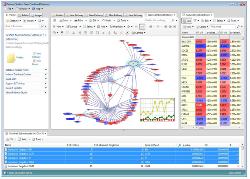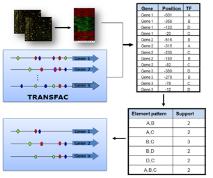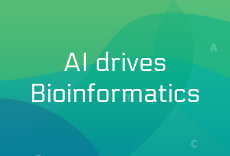[Quipu Issue Paper] Expression Study Ⅴ- Text-mining을 통한 대사회로 분석, Promoter 영역 분석을 통한 발현 조절 메카니즘 분석
- Posted at 2010/03/03 10:03
- Filed under 생물정보
연재 순서
1. Assembly
2. Variation study
3. Expression study
4. Epigenomics
5. Genome Annotation
6. Next Generation Bioinformatics
7. Data Management for web 2.0 Era
8. Semantic Network for Integrated Biology Data
9. Gene Network Discovery by Text-mining
10. Centralization for High-throughput Data Analysis
이번 연재에서는 어제에 이어 Next Generation Sequencing의 두 번째 Application인 Expression study에 대한 내용으로 Differentially Expressed Genes(DEGs) Functional annotation 중에 Text-mining을 통한 대사회로 분석과 Promoter 영역 분석을 통한 발현 조절 메카니즘 분석에 대해 알아보겠습니다.
대사회로 분석은 세포내 유전자들이 생물학적으로 기능이 유사하거나 동일한 조절 기작을 통해 동일 시간상에서 유사한 발현 양상을 보일 것이라는 가정 하에 이루어진다. 선별된 유전자들(DEGs) 사이에서의 대사회로 분석을 통하여 대사회로 내에서 유전자들의 발현양상에 따라 up-regulation 혹은 down-regulation 되는지 분석할 수 있다. 또한 이들 간의 signal 관계가 upstream에 존재하는지 down- stream에 존재하는지 여부를 분석할 수 있다. 이러한 분석이 가능한 프로그램으로는 Ariadne사의 Pathway Studio가 있다[16].
 그림 7. DEG 유전자의 pathway 분석
그림 7. DEG 유전자의 pathway 분석
DEGs를 이용한 pathway 분석으로 유전자간의 조절 관계와 upsteam, downstream 단백질을 GUI를 통한 그래픽으로 확인이 가능하다[16].
Pathway Studio는 차등발현유전자들을 조절하는 상위 조절인자를 분석하거나 차등발현유전자들이 공통적으로 작용하고 있는 질병, 세포내 프로세스 등을 분석할 수 있는 유용한 프로그램이다.
선별된 유전자에 대해서 유전자의 발현 양을 조절하고 세포내의 항상성 유지를 위해 여러 유전자들 간의 긴밀한 네트워크를 통해 이뤄지는 유전자 조절 메카니즘을 분석한다. 유전자의 구조 중에서 특히 유전자의 기능에 중요한 영향을 미치는 부분은 유전자의 발현을 조절하는 프로모터 영역이다. 프로모터를 포함한 유전자의 upstream에 존재하는 전사인자 binding site의 예측을 통해 유전자의 발현 조절이 어떠한 메카니즘을 통해 이뤄지는지를 분석한다.
 그림 8. Upstream regulation 분석.
그림 8. Upstream regulation 분석.
가장 대표적인 프로그램으로 BIOBASE사의 TRNASFAC을 꼽을 수 있다[15]. 실험적으로 검증된 전사인자들로 생물 전문가의 꼼꼼한 검증을 통해 구축된 데이터베이스는 현재 인간을 중심으로 식물, 효모R에 이르기까지 계속해서 확대 되고 있다. TRANSFAC의 서브 프로그램인 Patch와 Match를 활용하면 미지의 유전자 upstream 서열의 binding 가능한 전사인자를 검색할 수 있고, 이는 유전자 네트워크에서의 생물학적인 의미를 찾을 수 있는 기초 데이터가 된다.
다음 연재에서는 유전자와 엑손의 발현 및 발현된 유전자의 각종 변이 등을 한 번에 연구할 수 있는 RNA-Seq기술에 대해 알아보겠습니다.
많은 관심 부탁드립니다.
2. Fei Z, Tang X, Alba RM, White JA, Ronning CM, Martin GB, Tanksley SD, Giovannoni JJ. (2004) Comprehensive EST analysis of tomato and comparative genomics of fruit ripening. Plant J. 40, 47–59
3. Rensink WA, Lee Y, Liu J, Iobst S, Ouyang S, Buell CR. (2005) Comparative analyses of six solanaceous transcriptomes reveal a high degree of sequence conservation and species-specific transcripts. BMC Genomics. 6, 124
4. Ronning,C.M. et al. (2003) Comparative analyses of potato expressed sequence tag libraries. Plant Physiol. 131, 419–429
5. Guo J, Zhu P, Wu C, Yu L, Zhao S, Gu X. (2003) In silico analysis indicates a similar gene expression pattern between human brain and testis. Cytogenet Genome Res. 103, 58-62
6. Benjamini, Y., Daniel Yekutieli. (2001) The control of the false discovery rate in multiple hypotheses testing under dependency. Annal. Stat. 4(29), 1165–1188
7. Tsai CA, Hsueh HM, Chen JJ. (2003) Estimation of false discovery rates in multiple testing: application to gene microarray data. Biometrics. 59, 1071-81
8. Audic S, Claverie JM. (1997) The significance of digital gene expression profiles. Genome Res. 7, 986–995
9. Roche 454 : Products & Solutions - Multiplexing
(http://www.454.com/products-solutions/experimental-design-options/multiplexing.asp)
10. Tatusov RL, Koonin EV, Lipman DJ. (1997) A genomic perspective on protein families. Science. 278, 631-637
11. Kato T, Murata Y, Miura K, Asai K, Horton PB, Koji T, Fujibuchi W. (2006) Network-based de-noising improves prediction from microarray data, BMC Bioinformatics. 7, S4
12. Noh SJ, Lee K, Paik H, Hur CG. (2006) TISA: tissue-specific alternative splicing in human and mouse genes. DNA Res. 5, 229-243
13. Zeeberg BR, Feng W, Wang G, Wang MD, Fojo AT, Sunshine M, Narasimhan S, Kane DW, Reinhold WC, Lababidi S, Bussey KJ, Riss J, Barrett JC, Weinstein JN. (2003) GoMiner: a resource for biological interpretation of genomic and proteomic data, Genome Biol. 4, R28
14. GeneSpring GX : Products & Services - GeneSpring GX Software
(http://www.chem.agilent.com/en-US/products/software/lifesciencesinformatics/genespringgx/pages/default.aspx)
15. Wingender E, Chen X, Hehl R, Karas H, Liebich I, Matys V, Meinhardt T, Prüss M, Reuter I, Schacherer F. (2000) TRANSFAC: an integrated system for gene expression regulation. Nucleic Acids Research. 28, 316-319
16. PathwayStudio : Products-pathway Studio
(http://www.ariadnegenomics.com/products/pathwaystudio/)
17. Eveland AL, McCarty DR, Koch KE. (2007) Transcript profiling by 3'-untranslated region sequencing resolves expression of gene families. Plant Physiol. 146, 32-44.
18. Torres TT, Metta M, Ottenwälder B, Schlötterer C. (2008) Gene expression profiling by massively parallel sequencing. Genome Res. 1, 172-7.
19. Vega-Arreguín JC, Ibarra-Laclette E, Jiménez-Moraila B, Martínez O, Vielle-Calzada JP, Herrera-Estrella L, Herrera-Estrella A. (2009) Deep sampling of the Palomero maize transcriptome by a high throughput strategy of pyrosequencing. BMC Genomics. 10, 299.
20. Wang ET, Sandberg R, Luo S, Khrebtukova I, Zhang L, Mayr C, Kingsmore SF, Schroth GP, Burge CB. (2008) Alternative isoform regulation in human tissue transcriptomes. Nature. 2456, 70-76.
21. Johnson JM, Castle J, Garrett-Engele P, Kan Z, Loerch PM, Armour CD, Santos R, Schadt EE, Stoughton R, Shoemaker DD. (2003) Genome-wide survey of human alternative pre-mRNA splicing with exon junction microarrays. Science. 302, 2141-2144.
22. Ledford H. (2008) Human genes are multitaskers. Nature. 456, 9.
23. CLC Genomics Workbench: RNA-Seq analysis
(http://www.clcbio.com/index.php?id=1330&manual=RNA_Seq_analysis.html)
1. Assembly
2. Variation study
3. Expression study
4. Epigenomics
5. Genome Annotation
6. Next Generation Bioinformatics
7. Data Management for web 2.0 Era
8. Semantic Network for Integrated Biology Data
9. Gene Network Discovery by Text-mining
10. Centralization for High-throughput Data Analysis
이번 연재에서는 어제에 이어 Next Generation Sequencing의 두 번째 Application인 Expression study에 대한 내용으로 Differentially Expressed Genes(DEGs) Functional annotation 중에 Text-mining을 통한 대사회로 분석과 Promoter 영역 분석을 통한 발현 조절 메카니즘 분석에 대해 알아보겠습니다.
B. Text-mining을 통한 대사회로 분석
대사회로 분석은 세포내 유전자들이 생물학적으로 기능이 유사하거나 동일한 조절 기작을 통해 동일 시간상에서 유사한 발현 양상을 보일 것이라는 가정 하에 이루어진다. 선별된 유전자들(DEGs) 사이에서의 대사회로 분석을 통하여 대사회로 내에서 유전자들의 발현양상에 따라 up-regulation 혹은 down-regulation 되는지 분석할 수 있다. 또한 이들 간의 signal 관계가 upstream에 존재하는지 down- stream에 존재하는지 여부를 분석할 수 있다. 이러한 분석이 가능한 프로그램으로는 Ariadne사의 Pathway Studio가 있다[16].

Pathway Studio는 차등발현유전자들을 조절하는 상위 조절인자를 분석하거나 차등발현유전자들이 공통적으로 작용하고 있는 질병, 세포내 프로세스 등을 분석할 수 있는 유용한 프로그램이다.
C. Promoter 영역 분석을 통한 발현 조절 메카니즘 분석
선별된 유전자에 대해서 유전자의 발현 양을 조절하고 세포내의 항상성 유지를 위해 여러 유전자들 간의 긴밀한 네트워크를 통해 이뤄지는 유전자 조절 메카니즘을 분석한다. 유전자의 구조 중에서 특히 유전자의 기능에 중요한 영향을 미치는 부분은 유전자의 발현을 조절하는 프로모터 영역이다. 프로모터를 포함한 유전자의 upstream에 존재하는 전사인자 binding site의 예측을 통해 유전자의 발현 조절이 어떠한 메카니즘을 통해 이뤄지는지를 분석한다.

TransFac을 활용한 DEGs의 upstream에 존재하는 공통된 transcription factor를 탐색
가장 대표적인 프로그램으로 BIOBASE사의 TRNASFAC을 꼽을 수 있다[15]. 실험적으로 검증된 전사인자들로 생물 전문가의 꼼꼼한 검증을 통해 구축된 데이터베이스는 현재 인간을 중심으로 식물, 효모R에 이르기까지 계속해서 확대 되고 있다. TRANSFAC의 서브 프로그램인 Patch와 Match를 활용하면 미지의 유전자 upstream 서열의 binding 가능한 전사인자를 검색할 수 있고, 이는 유전자 네트워크에서의 생물학적인 의미를 찾을 수 있는 기초 데이터가 된다.
다음 연재에서는 유전자와 엑손의 발현 및 발현된 유전자의 각종 변이 등을 한 번에 연구할 수 있는 RNA-Seq기술에 대해 알아보겠습니다.
많은 관심 부탁드립니다.
참고문헌
1. Mortazavi A, Williams BA, McCue K, Schaeffer L, Wold B. (2008) Mapping and quantifying mammalian transcriptomes by RNA-Seq. Nat Methods. 7, 621-628.2. Fei Z, Tang X, Alba RM, White JA, Ronning CM, Martin GB, Tanksley SD, Giovannoni JJ. (2004) Comprehensive EST analysis of tomato and comparative genomics of fruit ripening. Plant J. 40, 47–59
3. Rensink WA, Lee Y, Liu J, Iobst S, Ouyang S, Buell CR. (2005) Comparative analyses of six solanaceous transcriptomes reveal a high degree of sequence conservation and species-specific transcripts. BMC Genomics. 6, 124
4. Ronning,C.M. et al. (2003) Comparative analyses of potato expressed sequence tag libraries. Plant Physiol. 131, 419–429
5. Guo J, Zhu P, Wu C, Yu L, Zhao S, Gu X. (2003) In silico analysis indicates a similar gene expression pattern between human brain and testis. Cytogenet Genome Res. 103, 58-62
6. Benjamini, Y., Daniel Yekutieli. (2001) The control of the false discovery rate in multiple hypotheses testing under dependency. Annal. Stat. 4(29), 1165–1188
7. Tsai CA, Hsueh HM, Chen JJ. (2003) Estimation of false discovery rates in multiple testing: application to gene microarray data. Biometrics. 59, 1071-81
8. Audic S, Claverie JM. (1997) The significance of digital gene expression profiles. Genome Res. 7, 986–995
9. Roche 454 : Products & Solutions - Multiplexing
(http://www.454.com/products-solutions/experimental-design-options/multiplexing.asp)
10. Tatusov RL, Koonin EV, Lipman DJ. (1997) A genomic perspective on protein families. Science. 278, 631-637
11. Kato T, Murata Y, Miura K, Asai K, Horton PB, Koji T, Fujibuchi W. (2006) Network-based de-noising improves prediction from microarray data, BMC Bioinformatics. 7, S4
12. Noh SJ, Lee K, Paik H, Hur CG. (2006) TISA: tissue-specific alternative splicing in human and mouse genes. DNA Res. 5, 229-243
13. Zeeberg BR, Feng W, Wang G, Wang MD, Fojo AT, Sunshine M, Narasimhan S, Kane DW, Reinhold WC, Lababidi S, Bussey KJ, Riss J, Barrett JC, Weinstein JN. (2003) GoMiner: a resource for biological interpretation of genomic and proteomic data, Genome Biol. 4, R28
14. GeneSpring GX : Products & Services - GeneSpring GX Software
(http://www.chem.agilent.com/en-US/products/software/lifesciencesinformatics/genespringgx/pages/default.aspx)
15. Wingender E, Chen X, Hehl R, Karas H, Liebich I, Matys V, Meinhardt T, Prüss M, Reuter I, Schacherer F. (2000) TRANSFAC: an integrated system for gene expression regulation. Nucleic Acids Research. 28, 316-319
16. PathwayStudio : Products-pathway Studio
(http://www.ariadnegenomics.com/products/pathwaystudio/)
17. Eveland AL, McCarty DR, Koch KE. (2007) Transcript profiling by 3'-untranslated region sequencing resolves expression of gene families. Plant Physiol. 146, 32-44.
18. Torres TT, Metta M, Ottenwälder B, Schlötterer C. (2008) Gene expression profiling by massively parallel sequencing. Genome Res. 1, 172-7.
19. Vega-Arreguín JC, Ibarra-Laclette E, Jiménez-Moraila B, Martínez O, Vielle-Calzada JP, Herrera-Estrella L, Herrera-Estrella A. (2009) Deep sampling of the Palomero maize transcriptome by a high throughput strategy of pyrosequencing. BMC Genomics. 10, 299.
20. Wang ET, Sandberg R, Luo S, Khrebtukova I, Zhang L, Mayr C, Kingsmore SF, Schroth GP, Burge CB. (2008) Alternative isoform regulation in human tissue transcriptomes. Nature. 2456, 70-76.
21. Johnson JM, Castle J, Garrett-Engele P, Kan Z, Loerch PM, Armour CD, Santos R, Schadt EE, Stoughton R, Shoemaker DD. (2003) Genome-wide survey of human alternative pre-mRNA splicing with exon junction microarrays. Science. 302, 2141-2144.
22. Ledford H. (2008) Human genes are multitaskers. Nature. 456, 9.
23. CLC Genomics Workbench: RNA-Seq analysis
(http://www.clcbio.com/index.php?id=1330&manual=RNA_Seq_analysis.html)
Posted by 人Co
- Tag
- Ariadne, BIOBASE, down-regulation, down-stream, insilicogen, PathwayStudio, Promoter, RNA-Seq, Text-mining, TRANSFAC, up-regulation, upstream, 대사회로분석, 발현 조절, 인실리코젠, 프로모터
- Response
- No Trackback , No Comment
- RSS :
- https://post-blog.insilicogen.com/blog/rss/response/50


